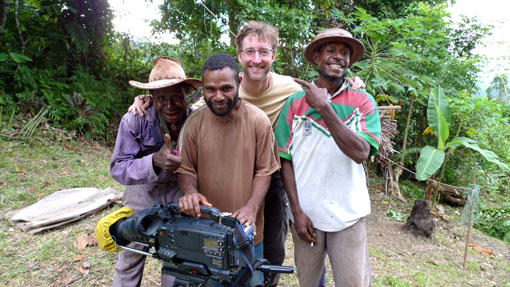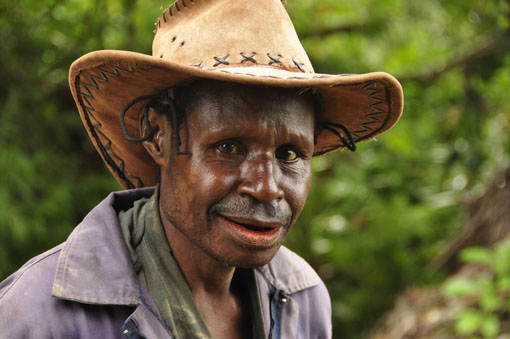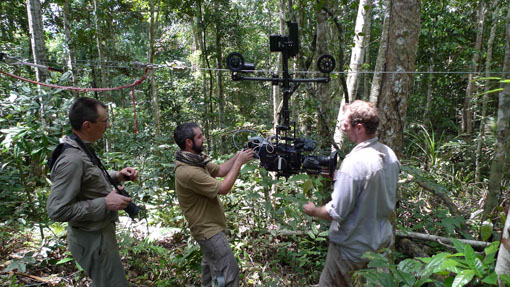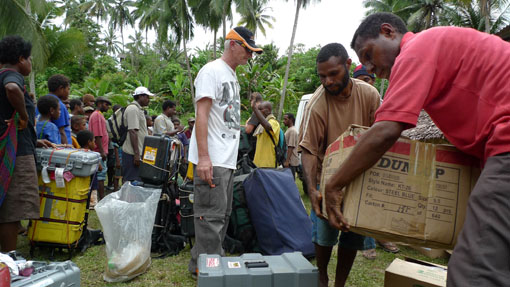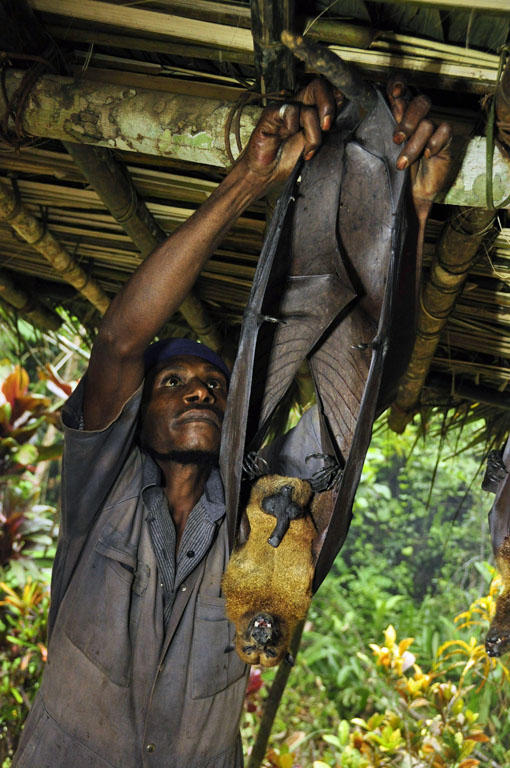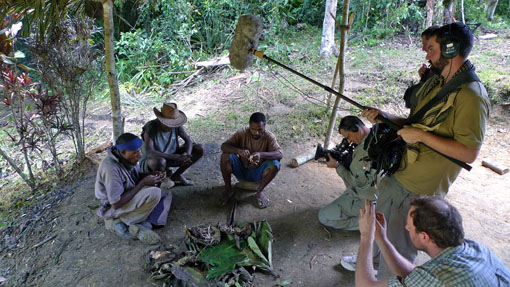15 Minutes of Fame Across the World
by Karina Moreton, Mongolian Fixer, Human Planet
The Human Planet series is made up of over 70 individal stories, each several minutes in length. As many of you will have gathered from the “Behind the Lens” snippets at the end of each episode, filming these sequences is never easy. Not only were there the challenges of the film crew – such as how to deal with ice melting; cliff edges and tides turning, there are the stories of the people portrayed. For some of them, the whirlwind of a film crew living with them was years ago now and they have gone about their daily lives since. Now that the series is out, will anything change for them?
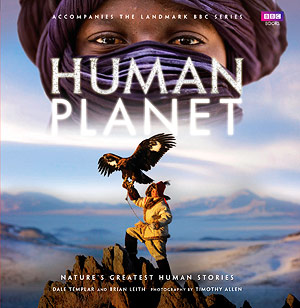
Berik from Human Planet's Mountains programme features on the book's cover
Berik from the Mountains programme is 16 years old. This is him and his eagle on the front of the book that accompanies the series. The book and programmes will be distributed worldwide and it’s hoped they will reach a huge audience. This is more than 15 minutes of fame! Around the world there is a culture of stardom – what would the teenagers from ‘Fame Academy’ and other talent shows give for this exposure? Some could worry that it might go to his head.
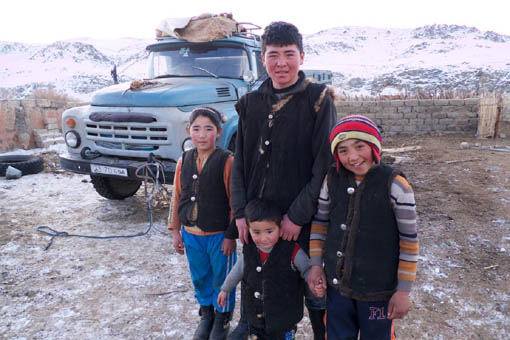
Berik with his cousins at his family home in Altansogts (image copyright Dina Mufti)
I’d like to show a photo or a clip of Berik looking at the book or DVD and giving his reactions. This however isn’t possible. Although copies of the book are on the way to Berik, they will take another 40 days to reach him. ’Outer’ Mongolia is considered to be the back of beyond, and Berik lives in one of the most remote parts of the country. I don’t anticipate that Berik will be exposed to his ‘fame’ until the next Eagle Festival.
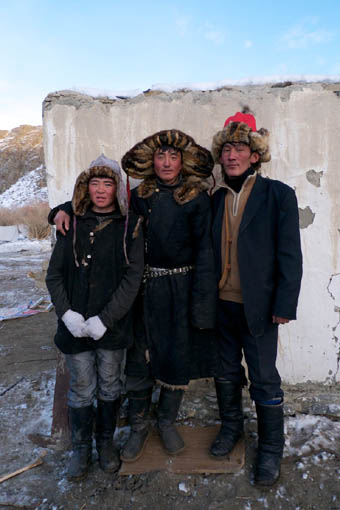
Berik with his older eagle hunting friends … before his first big hunt. (Image copyright Dina Mufti)
I think initially it will be the pages they feature in that will be the most thumbed through, though, with time, the other pages will be the ones that hold their attention. Over the last ten years of travelling through Mongolia, I have shown the reindeer herders of the north photographs of the camel herders in the south and I have shown young children photos of wolves and argali, animals that they have only dreamt of. Suddenly through this book, the Kazakh Eagle hunters of Mongolia are connected with not only the horse and camel breeders of central and southern Mongolia, but now they have shared an experience with the narwhal hunters of Greenland, mussel hunters of Canada and the honey gatherers of Nepal.
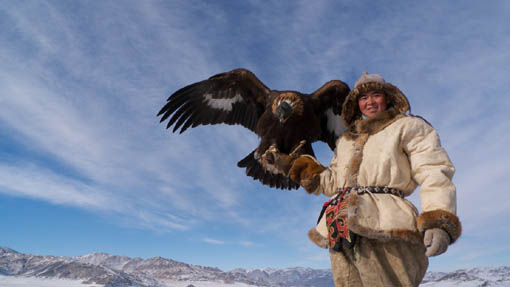
Berik, shortly after he catches his first fox …now officially a 'Kazakh man' (Image copyright Dina Mufti)
Mongolia is a landlocked country, so the images of the sea gypsies in the Pacific will no doubt enthral them. The bird of paradise hunter with his colourful headdress and nose piercing will amuse them. The naked Suri fighters will bemuse them. It is however I believe the story of the falconer in Dubai that will fascinate them. So much in common – for he also trains birds of prey to hunt, and yet they are in such a totally different world. Coming from a country with a rural population density of 0.9 people per square kilometre, it is almost inconceivable for a Mongolian to comprehend what it would be like to live in Dubai where there are 408 people per square kilometre.
Rural urban migration is a problem in Mongolia. Teenagers are attracted to the bright lights of the city. Berik might still be pulled away from his traditional way of life, but I think that perhaps the series will have changed the prospects for him and other young eagle hunters. By hosting occasional visitors who want to experience their culture first hand, this and other communities like them, have a renewed pride in what they do and a much-needed supplementary source of income.
After the characters in the Human Planet series have had their 15 minutes of fame, the book and the DVD will live on and spread their stories around the world. Many of the traditions and practises shown in the series may not survive until eternity.
Perhaps though, unknowingly, by exposing some of the characters to ‘others’ they may have slowed down the demise of man’s diversity?
Papua New Guinea - Wild Frontier
By Nicolas Brown, Producer/Director, Arctic and Mountains Team
Papua New Guinea has the feel of the Wild West. Because it’s a mountainous tropical island it doesn’t physically resemble a Spaghetti Western, but the larger than life characters and the ever-present threat of violence make it a frontier. This could be a set for Clint Eastwood- with a pierced nose.
As our small airplane nears its destination—Wewak town- we fly over the mighty Sepik River. Braided into a wide Delta of graceful interlocking ox bows, this is how rivers used to look hundreds of years ago. No channels or dams or bridges. The wildness is just a taste of what is around the corner.
On our descent, we are treated to a breathtaking overview. Wewak town is in the shadow of Mt. Turu, a 1600-metre high peak covered in dense jungle. But the real story—the one we have come to film—lies beneath the canopy, where literally hundreds of tribes make their living on the steep mountain slopes. My burning question is—exactly who have we come all this way to film?
In Papua New Guinea there are over 700 distinct tribes, in the East Sepik province (which is half the size of Ireland) there are 88 distinct languages spoken. Around this one single mountain- Mt. Turu- we counted 7 different ethnic groups. In terms of people, this place is wildly diverse.
This is the home of cannibalism and many say there are still tribes in the mountains that cannibalise each other. As recently the 1970s, four Dutch families were killed and eaten. Two years after that a priest and his 12 companions were killed.
Possibly more worrying for a BBC film crew, Wewak is famous for cargo cults. Prior to this trip, I had never heard of such a thing, but evidently during WWII the Japanese and Americans flew a lot of supplies—cargo- to the region. Once the war ended, the cargo stopped coming. In an attempt to get it back, local tribes evolved religious rituals that mimicked the activities of soldiers, such as wearing “headphones” made of wood and speaking into “radios” woven out of straw. You’d think they would have got tired of waiting for cargo by now, but evidently not.
When I suggested our original plan to fly to our location using helicopters, the image of us arriving from the sky with dozens of boxes of film equipment filled our local fixer with dread. “Are you crazy? You cannot come out of the sky carrying boxes of what looks like cargo—that would cause big trouble.” But, as we are about to find out, “big trouble” is coming anyway, in a different guise.
It starts on our first day. We had just loaded the vehicles with our filming equipment when the hotel owner enters and announces that a week ago, there was a jail-break in Port Moresby’ maximum security prison. Twelve of the most notorious criminals in PNG had escaped, including the most notorious of all—William Kapris. The hotel owner goes on to say that someone has just hijacked a 4×4 vehicle earlier this morning. Since William Kapris grew up near Wewak, the inference is that Kapris is back and is collecting 4x4s to escape into the mountains.
Two of the best 4×4 vehicles in town are ours- parked in front of the hotel, full of our gear. We debate our options. Some are suggesting that a BBC film crew would make a useful bargaining tool for a desperate criminal gang. Do we keep filming? Or do we hide in the hotel and watch the armed guards patrol the perimeter, while we put our feet up and drink beer? The decision falls to me.
I look at the sky which is moody and dark—this is the rainy season, and if we don’t leave now there’s a real chance that the roads will get so muddy that we will never reach our location. So I say, “let’s go filming, but keep our eyes and ears open.”
Of course, the minute we leave the hotel, everyone is a suspect. That man by the hedge—does he look like a mass murderer? That boy playing with his football against the wall—is he going to phone Kapris and tell him the 4x4s are on the way? On the road, the woman with her bag of vegetables—I imagine she is William’s sister who eventually liaises with the international hostage negotiators, saying “Don’t you think a BBC Producer’s life is worth a little more money than that? Pay up.”
Our visit to the local police is not encouraging. The Commander in Chief sees the BBC coming, and seizes a press opportunity. “Everything is under control—we have shoot to kill orders, and we are sure that we will find him and he will die.” I wanted to tell him, “We don’t care if you catch Kapris or not—we just don’t want us to be shot in some kind of crossfire confusion,” but I bit my lip.
We drive to our location without incident. At the village we are welcomed by the elders, and by our fascinating hero, Marcus. Marcus is a Yangoru Boiken hunter, but to the locals, he is a man feared for his magic powers.
To get our gear out to Marcus’ hunting grounds requires 40 some porters. So the whole village it seems comes under our employ. Our fixer AJ, who has done this before, makes a clear list of everyone’s names, and what we will pay them. And we set off.
On the way we are told never to stray from the path—not even to pee. Evidently, people from rival tribes will hide in the bushes, and then will leap out and stab you with a syringe filled with the poison of the giant centipedes that live here. Apparently it’s a very painful death.
Why someone would want to randomly murder you is not made clear. When I ask, the only answer that comes back is “witchcraft”. In the end I conclude that it is an effective way of controlling us—like telling children ghost stories so they don’t go wandering off at night.
We eventually film our sequence—which is a wonderful gothic tale that has never been filmed before. Marcus and his fellow hunters try to catch the giant fruit bats that fly over the canopy in the dead of night. How they catch them is ingenious and you can find out the whole story when you watch the mountains episode of Human Planet. 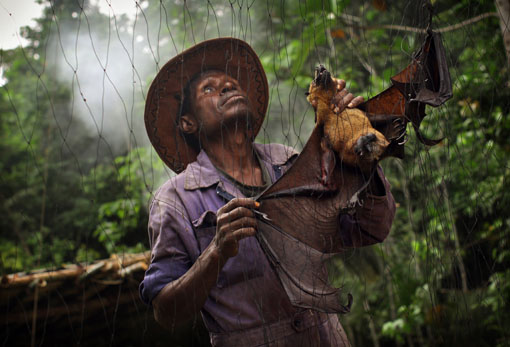
- Marcus capturing a bat in the net
We get to a point in the filming where we need to move locations to a different gap. It means a change in location, and a change in porters. So we are paying the porters and the trouble starts. Most people understand that in order to get paid, they need to have put their names on a list when they carried a load for us. But a few shifty looking men (who none of us had ever seen before) declare that they had worked for us but their names weren’t on the list. It gets heated. People are slamming fists, arguing with each other and with us. I can see the violence escalating.
So we decide to pay everyone double. And leave quickly. This puts a huge hole in our finances, but at least no-one has been hurt.
At our new location, there are more fees to be negotiated with the landowner. And we’re low on cash. But we make a deal, and begin filming. Then after about half a day, a man comes crashing through the jungle with a few henchmen wielding machetes. He declares that we are on his land, and he needs payment, or he will take action.
We explain that we have a deal in place with one person who owns the land. So who is this new guy? He says, “I am Joseph, tribal chief and the elder brother of the landowner.” Which makes Joseph a more senior landowner. And Joseph wasn’t informed about our project, which is against the tribal law. We immediately halt filming. We are back at the negotiating table.
Joseph has a remarkable command of legal sounding phrases, like “grievance” and “landowner rights”. And he wants money—a lot of it. And if we go home now, we can’t finish the film. Joseph seems to know this—he has a highly intuitive grasp of the art of blackmail.
Throughout the negotiations, I wryly note that Joseph’s younger brother—who we made a deal with in the first place—keeps schtum. He sees the possibility of more money coming his way, however indirectly. We are stuck, without enough cash to pay up, and with a half shot film.
Then, a few of our porters come over with a suggestion. They don’t like the blackmail that is going on, and they’ve never liked Joseph. He does this sort of thing all the time, and keeps all the money to himself. So they helpfully offer to get Joseph “drunk.”
“Oh that’s a nice gesture,” I say, “but it won’t really solve this predicament, will it?” They go on to explain that “getting someone drunk” is a euphemism for taking them into the woods and chopping them into bits with machetes. I can’t contain my horror—“Lord, no, don’t get him drunk! I don’t like the old codger, but that’s going way too far!”
In the end we compromise on a reduced fee for Joseph that pretty much ensures our “end of filming celebration” will be us drinking a round of tap water in the airport lounge. And Joseph is so pleased that he managed to squeeze more money from us that he invites a bunch of his friends to come watch us film. Every time he catches my eye, I wince, and it amuses him immensely. But we get the job done.
On our return journey I catch wind of a radio programme. It’s an English language call in show, and a voice speaks to the host. “This is William Kapris.” I am stunned by the meekness in his voice. To this day, I have no idea if this is a true story or just a prank, but the man claiming to be Kapris explains that the whole jail- break was organised by the government so that they could execute him on sight. It seems he knew some things about high-ranking officials that they didn’t want to come out in his trial. Now he’s on the run—maybe in Wewak—wanted dead or alive.
Like I said, Papua New Guinea is a bit of a frontier, and Wewak town belongs in the Wild West. Kapris is Jesse James. Joseph is Billy the Kid. And we are just a bunch of Westerners whose pockets were easily emptied.
Pack Your Thermals!
Summer in Mongolia - Pack Your Thermals!
A few weeks ago I wrote about my last trip to Mongolia back in the early 1990s when the country was in economic tatters. Well, I have just arrived back and I am delighted to say that everything has changed apart from the weather! Last time I went much earlier in the year and I expected it to be freezing , and it was! This time I really thought that by going in June there would be a chance of getting my legs out. It is after all on much the same latitude as London (where it’s been 30 degrees recently). We were lulled into a false sense of security when we got to the capital Ulaanbaatar - it was indeed sunny and warm.
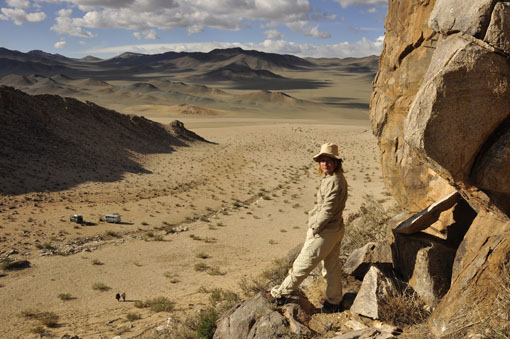
A bird's eye view
The next day we flew to the far West, Kazakh country, a dry high desert wrapped up by the Altai Mountains. Here the temperature dropped almost immediately and worst of all the wind picked up, adding the wind chill factor. Our small team spent all week working on a cliff edge in a valley with the winds pounding us. At one point I was wearing three bottom layers and five top layers (I wore less when I went to Antarctica!). Our wonderful local fixing team plied us with hot black tea in Great British tradition, and kept telling us that the weather had been wonderful the week before.
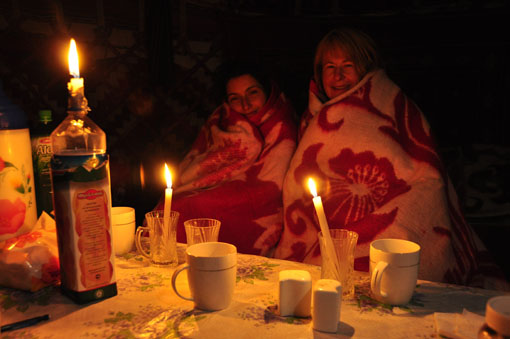 Dina (left) and Dale (right) wrapped up in yak hair blankets
Dina (left) and Dale (right) wrapped up in yak hair blanketsDina and I couldn’t wait to get into our Ger each night, but now the temperature dropped even further (as it usually does at night especially in high desert). As you will see from the picture we used every blanket available to us to keep warm; we both looked like extras from some clichéd Spaghetti Western. One thing’s for sure, if you are planning a trip to outer Mongolia in the summer don’t worry about forgetting a toothbrush, you’ll find plenty of those in the shops nowadays but whatever you do, don’t forget to pack your thermals!
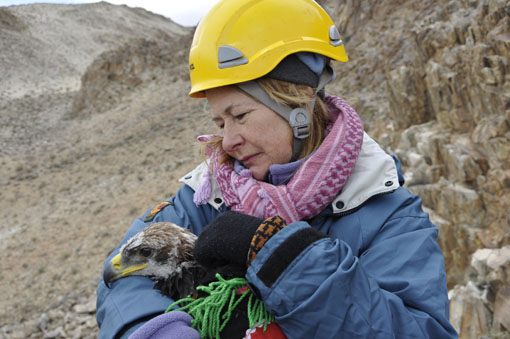
A local eagle keeps warm
Himalayan Odyssey - Episode 2
by Dina Mufti, Researcher, Arctic/Mountains team
Getting home …
Three days before leaving Dolpo in the high Himalayas of Nepal, I twist my ankle, twice. We are two days trek from our pick up point and nowhere near a doctor. We hire a decrepit horse for me to ride. But I am no rider. I think about the 5000m pass ahead and saddle sores, then focus on a hot shower and warm bed, and get on the horse.
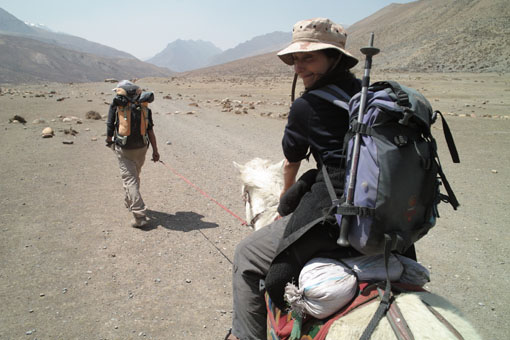
White horse to the rescue
The crew are ahead and I’m alone with the landscape. Lush river valleys, soaring peaks and a frozen river fill me with awe. I spot lammergeyers, Blue sheep, and Buddhist relics as I plod along. At the 5000m pass I am surrounded by glorious peaks, including Dhauligiri – one of the most famous peaks in the world.
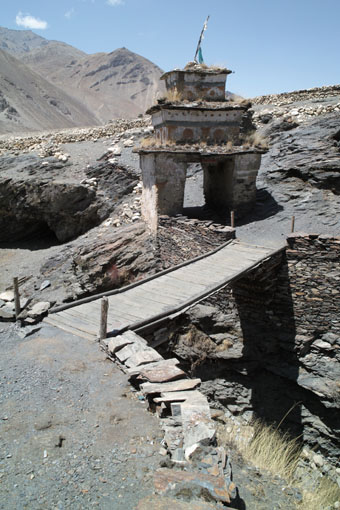
Then it’s all downhill. It’s too steep for the horse, so I use two sticks to walk - twisting my ankle a third time might break it. The horse and I are re-united in a wide river valley, lined with medieval mud houses where the smoke from fires inside remind me of home. The journey has taken seven hours. Children greet us - “Namaste sister”, dancing around the horse as we head to camp.
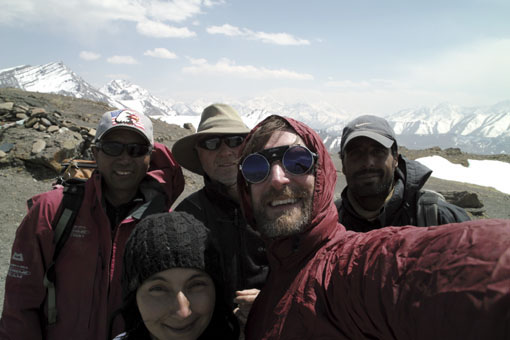
Tenzing Sherpa (back left) and the crew
The next morning we pack our gear and look to the skies… 7am … 7.30 ….8.15, nothing. We were expecting a Russian MI17 helicopter at 7.30, and it’s late. Later in the morning it can get too windy to land, but It’s the only way we can get out in time for the flights home. We want to take the sherpas with us, otherwise it’s a six day trek to their families. Suddenly a great shudder, and a beast of a helicopter comes hurtling down the valley. Tears and cheers of relief.
The helicopter lurches to the ground like a weary mammal. The clearly miserable pilot takes us in with a cursory glance before signalling ‘6 only’ - but there are 11 of us who need a ride.
Our fixer, Tenzing Sherpa, goes into negotiation overdrive but as soon as we load the kit it comes hurtling back out of the door, thrown out by the pilot’s sidekick. Challenging Tenzing is a dangerous thing. He is a formidable logistics man and no surly airman is going to man-handle him.
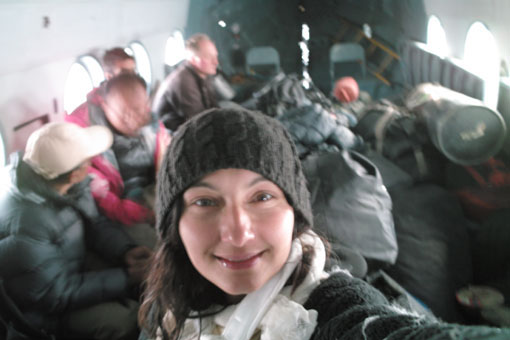
In the helicopter, sitting on the kit
With a lot of shouting seven of us manage to get on, sad to leave our sherpas to their trek. Boarding is frenetic and we barely say goodbye to these friends who have guided and saved our lives on more than one occasion. Our kit is thrown unceremoniously in the middle of the helicopter and I have to sit on top of it. Then a huge judder and we take off, waving goodbye through the murky windows as we rattle into the sky and are gone ….
Dale Templar, Series Producer, Human Planet
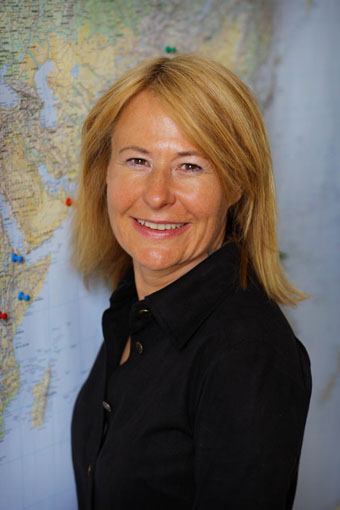
Error alert!
Documentary location cameras are without doubt fickle and temperamental beasts. Our camera beast of choice on Human Planet is the Panasonic Varicam, which films the stunning slo-mo footage we love to see in landmark documentaries. These are not cheap cameras, yet no matter what checks, tests and double checks they go through; no matter how much loving care we give them during their breaks from filming; no matter how much metaphorical cotton wool we pad and pack them in during transportation, recently they seem to have a knack of breaking down at the worst possible moments. The fact of the matter is, we can take dozens of silver boxes full of filming kit on location but if the camera doesn’t work, that’s it, literally end of story.
At the moment we have clearly upset the camera gods. This week our cameraman in Kenya, Warren Samuels, could not believe his luck. Day 1 on location and the lions he wants to film are, for once, in the right place, at the right time, doing the right thing. He rushes to unpack the camera, switches it on and in the viewfinder he gets ERROR flashing in red. It’s the moment of pure HORROR all TV camera operators face at some time or other. It will take us four days to get a new camera to him. Let’s hope the lions are understanding and realise that today’s performance was just a rehearsal.
A Himalayan Odyssey
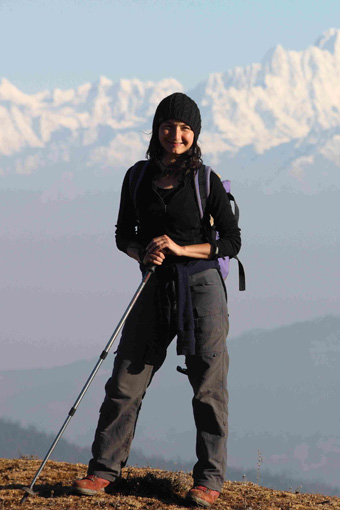
by Dina Mufti, Researcher, Arctic/Mountains team
Part I. Getting In …
I know the Himalayas and thought I knew what to expect, but working on Human Planet has taken me on a whole new journey.
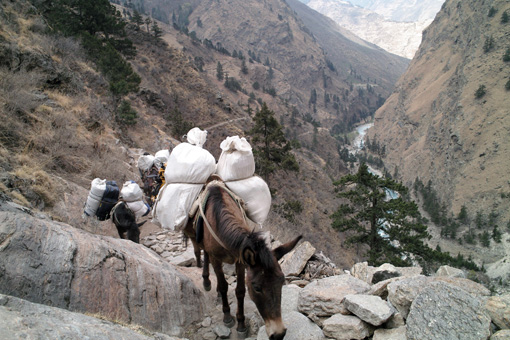
Our destination - Dolpo, a Buddhist enclave near the Tibetan border. A place so high that trees can’t grow, and electricity is a dream. The adventure begins right away. On the flight from steamy lowland Nepal, we rise through precipitous peaks in our Twin Otter plane, almost touching the mountains. Our organisational maestro is Tenzing Sherpa (no relation to the other Sherpa Tenzing, it’s like being called John Smith in Nepal) – a fixer so accomplished he could lead an army. In the remote Himalayas, nothing less will do.
On the flight Tenzing explains that flying at dawn avoids the winds that could blow us into a mountainside later in the day. Suddenly, waking up at 4am doesn’t seem so bad. Everyone is blown away by the jaw dropping views. Then a tiny runway appears through the parting peaks. We descend quickly and land, bouncing hard in our seats. As we get out, Nick our director says “Anyone seen the runway?” It’s 50m long – possibly the shortest runway in the world, with a hump in the middle and either end dropping into an abyss.
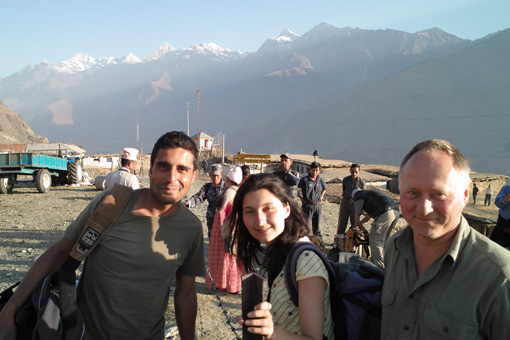
We're at one end of the runway, the other is at the edge of the abyss behind us
Now we have to trek to our final location and it’s an epic mission. We are joined by an army of porters, mules and yaks all needed to help us carry the 500kg of equipment. As we climb in altitude, the trail becomes steeper, loose underfoot - and one day disappears altogether….
We are climbing towards a 5000m pass, clambering up huge boulders. At times I lean so far into the rock that my knees scrape. The path is blocked by fallen trees angling steeply over a muddy slope and a raging river below. I am grasping and straddling a trunk when Tenzing shouts ‘ DON’T MOVE’ and 20 mules, carrying the gear, tear back round the corner towards us.
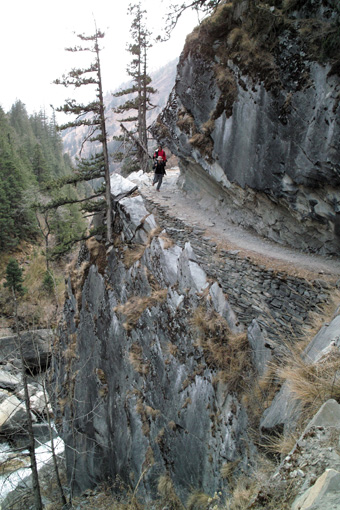
Negotiating the trail
Something has spooked them ahead. A loaded mule starts clambering over me but Tenzing screams and it backs off. The rest slip down the muddy slope towards the river, scrambling to keep their footing. I hear Nick swear as he watches helplessly as our gear heads towards the torrent. Then I start to slip too. It seems a long time until I feel Tenzing’s steady hand grip mine and he shouts “OK”.
Somehow these tough mules manage to navigate the mud and get back up the slope. We all marvel at them and everyone laughs at me clinging to the tree trunk like a slapstick comedy character. Tenzing finds another path and we go on, wondering what spooked them so badly.
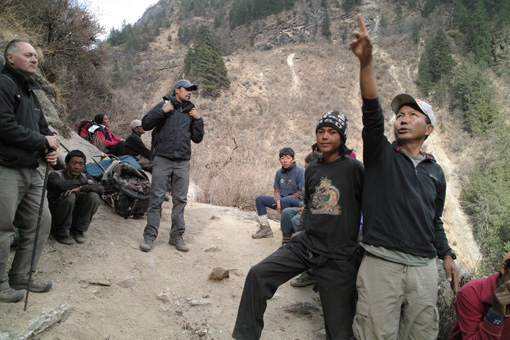
Tenzing Sherpa pointing out some loose rocks
Ahead we find a landslide that has wiped out the path and the Sherpas making a human chain to get everyone across. This is serious stuff. One slip here and it’s just the river below, no muddy slope to find your footing - just loose rocks and a ledge as wide as my foot. “Ok sister you can do it” … I take a deep breath and put one foot forward ….
Check the blog next week for Part 2, Getting Out..
Welcome to Human Planet
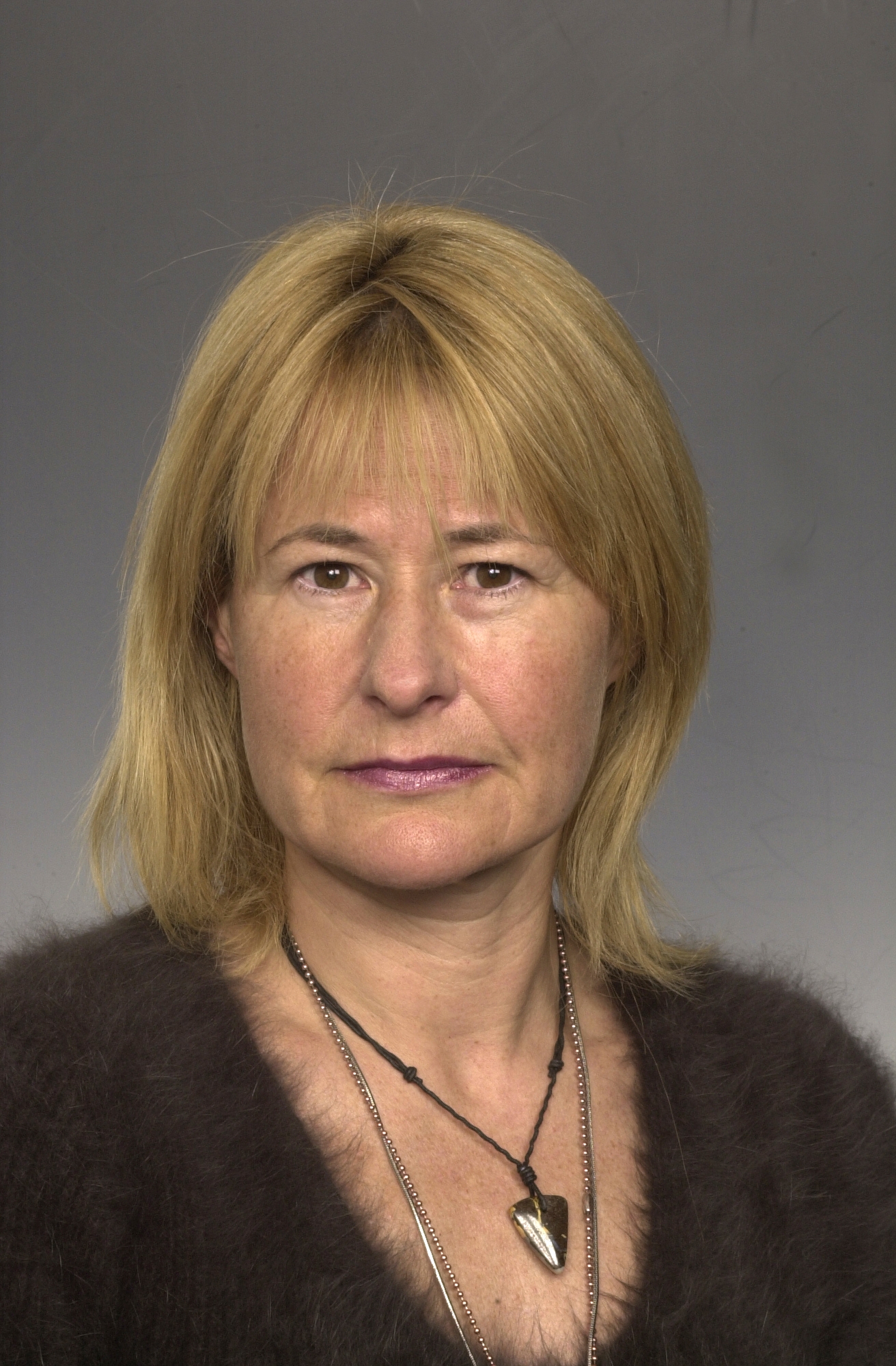
Dale Templar, Series Producer
by Dale Templar, Series Producer
So what is Human Planet? Human Planet is a new 8×50 minute landmark documentary series being made by BBC Television. The series celebrates the human species and looks at our relationship with the natural world by showing the remarkable ways we have adapted to life in every environment on earth. It is due to be transmitted in the UK in the New Year 2011 and will be rolled out across the world soon after.
The production team is split across two sites, one in Bristol and one in Cardiff.
In BBC Bristol we are part of the world renowned Natural History Unit. You may have heard of us, but if not, you’ve probably watched some of our programmes. Many have been presented or narrated by Sir David Attenborough, like Planet Earth and Blue Planet. Most recently we’ve just finished Nature’s Great Events which our own executive producer, Brian Leith, worked on.
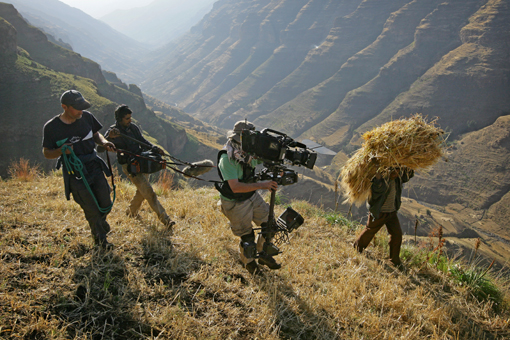
BBC Human Planet : Simien Mountains
BBC Wales, based in Cardiff, are probably best known in the UK right now for producing high end popular dramas like Doctor Who. Torchwood, another sci-fi doc that comes out of Cardiff, is also an HD production and Human Planet will be using the same excellent post-production facilities. The factual department is best known for its ground-breaking anthropology documentary series Tribe.
In total we have a core team of 20 phenomenally talented programme makers, who come with a wide range of skills and experiences. Working with us are some of the best wildlife and documentary camera crews and fixers in the world. For the first time we have a dedicated stills photographer, Timothy Allen, who will be posting his own Human Planet blog every week at http://timothyallen.blogs.bbcearth.com/
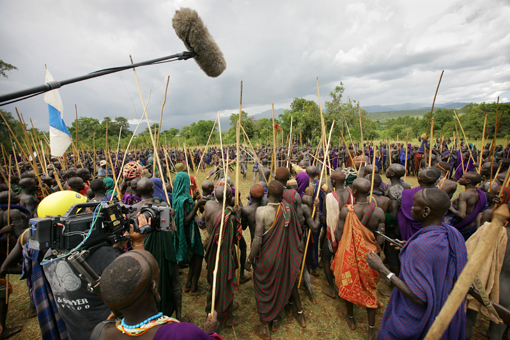
BBC Human Planet : Suri stick fight
The series started in full production in the summer of 2008 and we will be shooting over 70 stories in some of the most remote locations on earth in around 40 different countries.
Each episode will focus on one single environment: desert, jungles, arctic, grasslands, rivers, mountains, oceans and urban. Many of the stories are extremely dramatic and will show how we have successfully adapted and survived in the most challenging places on the planet.
As from next week each member of the team will be blogging their stories from the Human Planet. I will keep you updated on where everyone is and give you general news about the series.
Currently, we have teams that have just come back from the remote southern region of Mongolia, filming for the desert episode. On location are the Jungles and Mountains team who are in the Central African Republic and Nepal. I’ll let you work out which team is where!
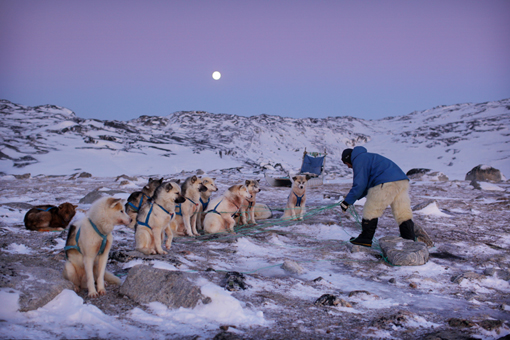
BBC Human Planet : Arctic Dawn
That’s it for now …enjoy the photos and the sneak preview from the series. See the link if you’d like to read what Timothy Allen’s been up to and don’t forget to explore the new BBC Earth site too. Look out for the regular Friday posting from the Human Planet team, with fascinating stories and tales from both our many locations and from the office.
